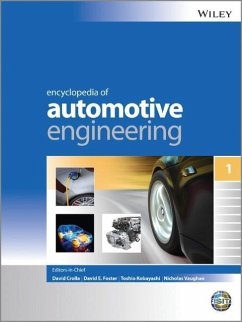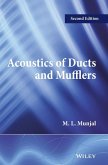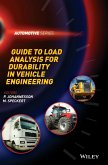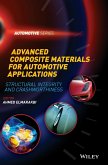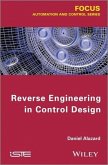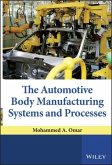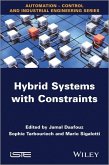David Crolla
Encyclopedia of Automotive Engineering
David Crolla
Encyclopedia of Automotive Engineering
- Gebundenes Buch
- Merkliste
- Auf die Merkliste
- Bewerten Bewerten
- Teilen
- Produkt teilen
- Produkterinnerung
- Produkterinnerung
Erstmals eine umfassende und einheitliche Wissensbasis und Grundlage für weiterführende Studien und Forschung im Bereich der Automobiltechnik.
Die Encyclopedia of Automotive Engineering ist die erste umfassende und einheitliche Wissensbasis dieses Fachgebiets und legt den Grundstein für weitere Studien und tiefgreifende Forschung. Weitreichende Querverweise und Suchfunktionen ermöglichen erstmals den zentralen Zugriff auf Detailinformationen zu bewährten Branchenstandards und -verfahren. Zusammenhängende Konzepte und Techniken aus Spezialbereichen lassen sich so einfacher verstehen. Neben…mehr
Andere Kunden interessierten sich auch für
![Acoustics of Ducts and Muffler Acoustics of Ducts and Muffler]() M. L. MunjalAcoustics of Ducts and Muffler150,99 €
M. L. MunjalAcoustics of Ducts and Muffler150,99 €![Guide to Load Analysis for Durability in Vehicle Engineering Guide to Load Analysis for Durability in Vehicle Engineering]() P JohannessonGuide to Load Analysis for Durability in Vehicle Engineering137,99 €
P JohannessonGuide to Load Analysis for Durability in Vehicle Engineering137,99 €![Advanced Composite Materials for Automotive Applications Advanced Composite Materials for Automotive Applications]() Ahmed ElmarakbiAdvanced Composite Materials for Automotive Applications137,99 €
Ahmed ElmarakbiAdvanced Composite Materials for Automotive Applications137,99 €![Reverse Engineering in Control Design Reverse Engineering in Control Design]() Daniel AlazardReverse Engineering in Control Design160,99 €
Daniel AlazardReverse Engineering in Control Design160,99 €![The Automotive Body Manufacturing Systems and Processes The Automotive Body Manufacturing Systems and Processes]() Mohammed A. OmarThe Automotive Body Manufacturing Systems and Processes116,99 €
Mohammed A. OmarThe Automotive Body Manufacturing Systems and Processes116,99 €![The Shock Absorber Handbook The Shock Absorber Handbook]() John DixonThe Shock Absorber Handbook120,99 €
John DixonThe Shock Absorber Handbook120,99 €![Hybrid Systems with Constraints Hybrid Systems with Constraints]() Hybrid Systems with Constraints160,99 €
Hybrid Systems with Constraints160,99 €-
-
-
Erstmals eine umfassende und einheitliche Wissensbasis und Grundlage für weiterführende Studien und Forschung im Bereich der Automobiltechnik.
Die Encyclopedia of Automotive Engineering ist die erste umfassende und einheitliche Wissensbasis dieses Fachgebiets und legt den Grundstein für weitere Studien und tiefgreifende Forschung. Weitreichende Querverweise und Suchfunktionen ermöglichen erstmals den zentralen Zugriff auf Detailinformationen zu bewährten Branchenstandards und -verfahren. Zusammenhängende Konzepte und Techniken aus Spezialbereichen lassen sich so einfacher verstehen. Neben traditionellen Themen des Fachgebiets beschäftigt sich diese Enzyklopädie auch mit "grünen" Technologien, dem Übergang von der Mechanik zur Elektronik und den Möglichkeiten zur Herstellung sicherer, effizienterer Fahrzeuge unter weltweit unterschiedlichen wirtschaftlichen Rahmenbedingungen.
Das Referenzwerk behandelt neun Hauptbereiche: (1) Motoren: Grundlagen; (2) Motoren: Design; (3) Hybrid-und Elektroantriebe; (4) Getriebe- und Antriebssysteme; (5) Chassis-Systeme; (6) Elektrische und elektronische Systeme; (7) Karosserie-Design; (8) Materialien und Fertigung; (9) Telematik.
- Zuverlässige Darstellung einer Vielzahl von Spezialthemen aus dem Bereich der Automobiltechnik.
- Zugängliches Nachschlagewerk für Jungingenieure und Studenten, die die technologischen Grundlagen besser verstehen und ihre Kenntnisse erweitern möchten.
- Wertvolle Verweise auf Detailinformationen und Forschungsergebnisse aus der technischen Literatur.
- Entwickelt in Zusammenarbeit mit der FISITA, der Dachorganisation nationaler Automobil-Ingenieur-Verbände aus 37 Ländern und Vertretung von über 185.000 Ingenieuren aus der Branche.
- Erhältlich als stets aktuelle Online-Ressource mit umfassenden Suchfunktionen oder als Print-Ausgabe in sechs Bänden mit über 4.000 Seiten.
Ein wichtiges Nachschlagewerk für Bibliotheken und Informationszentren in der Industrie, bei Forschungs- und Schulungseinrichtungen, Fachgesellschaften, Regierungsbehörden und allen Ingenieurstudiengängen.
Richtet sich an Fachingenieure und Techniker aus der Industrie, Studenten höherer Semester und Studienabsolventen, Forscher, Dozenten und Ausbilder, Branchenanalysen und Forscher.
Die Encyclopedia of Automotive Engineering ist die erste umfassende und einheitliche Wissensbasis dieses Fachgebiets und legt den Grundstein für weitere Studien und tiefgreifende Forschung. Weitreichende Querverweise und Suchfunktionen ermöglichen erstmals den zentralen Zugriff auf Detailinformationen zu bewährten Branchenstandards und -verfahren. Zusammenhängende Konzepte und Techniken aus Spezialbereichen lassen sich so einfacher verstehen. Neben traditionellen Themen des Fachgebiets beschäftigt sich diese Enzyklopädie auch mit "grünen" Technologien, dem Übergang von der Mechanik zur Elektronik und den Möglichkeiten zur Herstellung sicherer, effizienterer Fahrzeuge unter weltweit unterschiedlichen wirtschaftlichen Rahmenbedingungen.
Das Referenzwerk behandelt neun Hauptbereiche: (1) Motoren: Grundlagen; (2) Motoren: Design; (3) Hybrid-und Elektroantriebe; (4) Getriebe- und Antriebssysteme; (5) Chassis-Systeme; (6) Elektrische und elektronische Systeme; (7) Karosserie-Design; (8) Materialien und Fertigung; (9) Telematik.
- Zuverlässige Darstellung einer Vielzahl von Spezialthemen aus dem Bereich der Automobiltechnik.
- Zugängliches Nachschlagewerk für Jungingenieure und Studenten, die die technologischen Grundlagen besser verstehen und ihre Kenntnisse erweitern möchten.
- Wertvolle Verweise auf Detailinformationen und Forschungsergebnisse aus der technischen Literatur.
- Entwickelt in Zusammenarbeit mit der FISITA, der Dachorganisation nationaler Automobil-Ingenieur-Verbände aus 37 Ländern und Vertretung von über 185.000 Ingenieuren aus der Branche.
- Erhältlich als stets aktuelle Online-Ressource mit umfassenden Suchfunktionen oder als Print-Ausgabe in sechs Bänden mit über 4.000 Seiten.
Ein wichtiges Nachschlagewerk für Bibliotheken und Informationszentren in der Industrie, bei Forschungs- und Schulungseinrichtungen, Fachgesellschaften, Regierungsbehörden und allen Ingenieurstudiengängen.
Richtet sich an Fachingenieure und Techniker aus der Industrie, Studenten höherer Semester und Studienabsolventen, Forscher, Dozenten und Ausbilder, Branchenanalysen und Forscher.
Produktdetails
- Produktdetails
- Verlag: Wiley & Sons
- 1. Auflage
- Seitenzahl: 4101
- Erscheinungstermin: 23. März 2015
- Englisch
- Abmessung: 312mm x 262mm x 251mm
- Gewicht: 12837g
- ISBN-13: 9780470974025
- ISBN-10: 0470974028
- Artikelnr.: 41748277
- Herstellerkennzeichnung
- Libri GmbH
- Europaallee 1
- 36244 Bad Hersfeld
- gpsr@libri.de
- Verlag: Wiley & Sons
- 1. Auflage
- Seitenzahl: 4101
- Erscheinungstermin: 23. März 2015
- Englisch
- Abmessung: 312mm x 262mm x 251mm
- Gewicht: 12837g
- ISBN-13: 9780470974025
- ISBN-10: 0470974028
- Artikelnr.: 41748277
- Herstellerkennzeichnung
- Libri GmbH
- Europaallee 1
- 36244 Bad Hersfeld
- gpsr@libri.de
Executive Editor-in-Chief: David Crolla (deceased), University of Leeds, UK. Regional Editor-in-Chief (North America): David Foster, University of Wisconsin-Madison, WI, USA. Regional Editor-in-Chief (Asia): Toshio Kobayashi, Japan Automotive Research Institute, Tokyo, Japan. Regional Editor-in-Chief (Europe): Nichols Vaughan, Cranfield University, UK.
Editorial Board
Dedication
Foreword
Preface
Part 1
Operating Principles
Thermordynamic Analysis
Fundamental Chemical Kinetics
Fundamental Combustion Modes
Solving Combustion Chemistry in Engine Simulations
NOx Formation and Models
UHC and CO Formation and Models
Particulate Formation and Models
Gas Exchange - Breathing and Air Management
Fuel Introduction
In-Cylinder Flow
Spark Ignition Combustion
Diesel and Diesel LTC Combustion
Advanced Compression-Ignition Combustion for Ultra-Low NOx and Soot
Pressure and Heat Release Analysis
Zero- and One-Dimensional Methodologies and Tools
Multidimensional Simulation
Fuels for Engines and the Impact of Fuel Composition on Engine Performance
Intake Boosting
Exhaust Gas Energy Recovery
Engine Thermal Management
Lubrication and Friction
Gas Aftertreatment Systems
Solid/Condensed Phase Aftertreatment Systems
Engine Performance
Exhaust Emissions
Fundamentals
Trends -- Spark Ignition
Trends -- Compression Ignition
Part 2
Automotive Diesel Engine Development Trends
Critical layout dimensions
Cranktrain Development
Cooling Systems
Lubrication systems
Piston and ring development
Valvetrain development
Material and Process Selection -- Cylinder Blocks and Heads
Block and Head Analysis
Gaskets and Sealing
NVH Considerations in Engine Development
Turbocharging
Supercharging
Diesel Fuel Injection Systems
Emission Control Systems - Oxides of nitrogen
Stoichiometric Exhaust Emission Control
Exhaust Emission Control Considerations for Diesel Engines
Engine Management Systems
Engine/Transmission Matching
Drive Cycles
Fuel economy optimization
Part 3
Overview of Electric, Hybrid and Fuel Cell Vehicles
EV powertrain configuration
EV powertrain parameters
EV auxilaries
Basic consideration
Micro, mild and full hybrid
Series Hybrid Electric Vehicles (SHEVs)
Parallel Hybrid Electric Vehicles (Parallel HEVs)
Series-Parallel Hybrid Electric Vehicles
Range extender EV
All-Wheel Drive Hybrid System
EVT and E-CVT for Full Hybrid Electric Vehicles
Power and Energy requirements for electric and hybrid vehicles
Rechargeable Battery Basics
Advanced batteries for vehicle applications
Batteries indication and management
Battery safety for lithium batteries in vehicle applications
Fuel Cell Powered Vehicles
Ultracapacitors in electric drive vehicles
General requirement of traction motor drives
DC motor drives
Induction motor drives
Future direction of traction motor drives
Regenerative braking systems
Energy management systems of EVs
Energy management systems of HEVs
Battery charging standards
Communication of Electric Vehicles
Voltage Control and Frequency Control
Impact of electric vehicles on low-voltage supply systems
Part 4
General Introduction - basic definitions, structure of Part 4
Transmission Gear Design
Loads & Bearings and Bearing Failure
Mechanics of contacting surfaces
Tribological optimisation in the powertrain
Synchronisers - gear change process, loads, timing, shift effort, thermal
loads, materials and tolerances
Dry Clutch
Clutch Wet
Automotive Torque Converters
Manual (MT) - layouts, design considerations, packaging & manual shift
mechanism, manufacturing & assembly
Automatic Transmissions - geartrain combinations, components, design
considerations, hydraulic system, packaging, manuf., assembly
The variable pulley CVT
Traction drive CVT
Power Split Configurations
Dual Mass Flywheel (DMF)
Propshafts (Driveshafts)
Coupling connections and splines
Articulated Joints and Couplings -- Cardan and CV Joints
Axle Systems
Basic Open Differentials
Passive and Active Limited Slip Differentials
Torque Transfer with AWD Systems
Drive train noise, vibration and harshness
Clutch Actuation
Launch Control
Control systems and strategies for automated manual and double clutch
transmissions
AT Control -- actuation methods & system integration, gear choice, gear
shift strategy & process, adaptive features
CVT Control - system integration, ratio choice, shift dynamics & strategy,
adaptive features, engine calibration, em assist
Part 5
Possibilities of coil springs and fibre reinforced suspension parts
Air suspension systems, what advanced applications may be possible?
The harshness of air springs in passenger cars
Air supply for advanced applications
Technology of active shock absorbers and benefits in regards of ride and
handling
Suspension arms, steel versus aluminium,where are the benefits?
Performance Target Conflicts in Normal Tires and Ultra High Performance
(UHP) Tires
Tyre pressure monitoring systems
Brake systems, an overview
Carbon fibre reinforced siliconcarbide: a new brake disk material
The development of alternative brake systems
The Cooperation of Regenerative Braking and Friction Braking in Fuel Cell-,
Hybrid- and Electric Vehicles
Designing twist beam axles
ULSAS -- Suspensions, a comparison of rear suspension design
Light weight front suspensions, a comparison
Active front steering for passenger cars
New Electrical Power Steering Systems
Steer by Wire, Potential and Challenges
The potential for handling improvements by global chassis control
Customer oriented Evaluation of Vehicle Handling Characteristics
Automated Driving
Global Chassis Control in Passenger Cars
Chassis Control Systems - A Look into the Future
Torque vectoring by drive train systems
Chassis modeling and optimization by the advanced method ABE
System Simulation in DSHPLUS, What applications are possible?
Comparison of the modeling techniques for chassis applications. An advice
for the user
Part 6
Historical Overview of Electronics and Automobiles: Breakthroughs and
Innovation by Electronics and Electrical Technology
ECU technologies from components to ECU configuration
Diversification of electronics and electrical systems and the technologies
for the integrated systems
Microcomputers and Related Technologies: Enlargement of Software Size,
Algorithms, Architectures, Hierarchy Design, Functional Decomposition, and
Standardization
Increase of ECU and Wire harness, JB simplify and decrease networks
ECU Design and Reliability
Manufacturing: An Introduction to Production Technology, SCM, and Quality
Assurance
In-Vehicle Network
Hardware-in-the-Loop Simulation
The Wire Harness
Batteries
Generators and Charging Control
Starter
Applications of radio wave technologies to vehicles
Applications of image recognition technologies to vehicles
Vehicle safety, Functional safety, OBD diagnosis
Interfaces between Sensors and ECUs
Various types of sensors
Ceramics sensors for power train ECU systems
Semiconductor Sensor (1)--Sensors for Power Trains
Semiconductor Sensors (2): Sensors for Safety Systems
Semiconductor Sensors (3): Optical Sensors
Various Kinds of Actuators and Signal Interfaces
Engine ECU systems
Hybrid Systems and High Voltage Components
Chassis ECU (Vehicle dynamics, ABS)
Chassis ECU (Steering)
Chassis ECU (ACC)
Body ECU Cluster
Body ECU (airbag)
Body and Lighting ECU (Key-less Entry, Sonar, HID, LED Usage for Lamps)
Car air conditioning and electronics: analog, digital control and zone
management
Car navigation
Telecommunications
Active safety, pre-collision safety and other safety products (millimeter
wave, image recognition, laser)
Part 7
Body design, overview, targeting a good balance between all vehicle
functionalities
Innovative structural design
The Fascination of Car Body Manufacture: Requirements for car body
manufacture from viewpoint of production
Styling of cars, from sketch to realisation, main trends and milestones
Fundamentals, basic principals in road vehicle aerodynamics & design
Exterior vehicle noise development: assessment and control
Vehicle vibration and harshness
Vehicle architecture for meeting anthropometric, posture, comfort, health
requirements of passengers
Human Machine Interface design in modern vehicles
Vehicle seat design, development and manufacturing
Physics of car crashes: design concepts for safer cars
Reparability and insurance ratings in the development of cars
Adaptive Restraint Systems: Towards Integral Safety
Pedestrian protection, overview
Part 8
Processing of Steels
Wrought Aluminum Alloys: Grades and Properties and Processing
Automotive Applications for Magnesium
Automotive Applications for Titanium
Processing of Polymers
Application of Elastomeric Components for Noise and Vibration Isolation in
the Automotive Industry
Trim
Hybrid Structures
Metal Matrix Composites: Automotive Applications
Automotive Glazing
Recycling of Polymers & Composites
Biopolymers & Biocomposites
Automotive Environmental Life Cycle Assessment
Part 9
Intelligent Transport Systems: Overview and Structure (history,
applications, architectures)
Intelligent Transport Systems: Market and Policies
Evolution and Future Trends
Technologies - Communication: Mobile
Technologies - Communication: Wireless LAN-based Vehicular Communication
Technologies - Positioning: GNSS
Tracking and navigation for goods and people
In-vehicle sensors
Data Acquisition by Roadside Detection
Technologies - Data Acquisition: Data fusion
Applications - Intelligent Vehicles: Driver Information
Driver Assistance
Applications - Intelligent Roads and Cooperative Systems: Urban Traffic
Management
Advanced Highway Management Systems
Road Traffic and Travel Information (RTTI)
Logistics and Fleet Management
Tolling, Mobility Pricing
Applications - Further Applications: Emergency Services, eCall
Quality Management in ITS
IT-Security for Communicating Automotive Systems
Driver Distraction
Dedication
Foreword
Preface
Part 1
Operating Principles
Thermordynamic Analysis
Fundamental Chemical Kinetics
Fundamental Combustion Modes
Solving Combustion Chemistry in Engine Simulations
NOx Formation and Models
UHC and CO Formation and Models
Particulate Formation and Models
Gas Exchange - Breathing and Air Management
Fuel Introduction
In-Cylinder Flow
Spark Ignition Combustion
Diesel and Diesel LTC Combustion
Advanced Compression-Ignition Combustion for Ultra-Low NOx and Soot
Pressure and Heat Release Analysis
Zero- and One-Dimensional Methodologies and Tools
Multidimensional Simulation
Fuels for Engines and the Impact of Fuel Composition on Engine Performance
Intake Boosting
Exhaust Gas Energy Recovery
Engine Thermal Management
Lubrication and Friction
Gas Aftertreatment Systems
Solid/Condensed Phase Aftertreatment Systems
Engine Performance
Exhaust Emissions
Fundamentals
Trends -- Spark Ignition
Trends -- Compression Ignition
Part 2
Automotive Diesel Engine Development Trends
Critical layout dimensions
Cranktrain Development
Cooling Systems
Lubrication systems
Piston and ring development
Valvetrain development
Material and Process Selection -- Cylinder Blocks and Heads
Block and Head Analysis
Gaskets and Sealing
NVH Considerations in Engine Development
Turbocharging
Supercharging
Diesel Fuel Injection Systems
Emission Control Systems - Oxides of nitrogen
Stoichiometric Exhaust Emission Control
Exhaust Emission Control Considerations for Diesel Engines
Engine Management Systems
Engine/Transmission Matching
Drive Cycles
Fuel economy optimization
Part 3
Overview of Electric, Hybrid and Fuel Cell Vehicles
EV powertrain configuration
EV powertrain parameters
EV auxilaries
Basic consideration
Micro, mild and full hybrid
Series Hybrid Electric Vehicles (SHEVs)
Parallel Hybrid Electric Vehicles (Parallel HEVs)
Series-Parallel Hybrid Electric Vehicles
Range extender EV
All-Wheel Drive Hybrid System
EVT and E-CVT for Full Hybrid Electric Vehicles
Power and Energy requirements for electric and hybrid vehicles
Rechargeable Battery Basics
Advanced batteries for vehicle applications
Batteries indication and management
Battery safety for lithium batteries in vehicle applications
Fuel Cell Powered Vehicles
Ultracapacitors in electric drive vehicles
General requirement of traction motor drives
DC motor drives
Induction motor drives
Future direction of traction motor drives
Regenerative braking systems
Energy management systems of EVs
Energy management systems of HEVs
Battery charging standards
Communication of Electric Vehicles
Voltage Control and Frequency Control
Impact of electric vehicles on low-voltage supply systems
Part 4
General Introduction - basic definitions, structure of Part 4
Transmission Gear Design
Loads & Bearings and Bearing Failure
Mechanics of contacting surfaces
Tribological optimisation in the powertrain
Synchronisers - gear change process, loads, timing, shift effort, thermal
loads, materials and tolerances
Dry Clutch
Clutch Wet
Automotive Torque Converters
Manual (MT) - layouts, design considerations, packaging & manual shift
mechanism, manufacturing & assembly
Automatic Transmissions - geartrain combinations, components, design
considerations, hydraulic system, packaging, manuf., assembly
The variable pulley CVT
Traction drive CVT
Power Split Configurations
Dual Mass Flywheel (DMF)
Propshafts (Driveshafts)
Coupling connections and splines
Articulated Joints and Couplings -- Cardan and CV Joints
Axle Systems
Basic Open Differentials
Passive and Active Limited Slip Differentials
Torque Transfer with AWD Systems
Drive train noise, vibration and harshness
Clutch Actuation
Launch Control
Control systems and strategies for automated manual and double clutch
transmissions
AT Control -- actuation methods & system integration, gear choice, gear
shift strategy & process, adaptive features
CVT Control - system integration, ratio choice, shift dynamics & strategy,
adaptive features, engine calibration, em assist
Part 5
Possibilities of coil springs and fibre reinforced suspension parts
Air suspension systems, what advanced applications may be possible?
The harshness of air springs in passenger cars
Air supply for advanced applications
Technology of active shock absorbers and benefits in regards of ride and
handling
Suspension arms, steel versus aluminium,where are the benefits?
Performance Target Conflicts in Normal Tires and Ultra High Performance
(UHP) Tires
Tyre pressure monitoring systems
Brake systems, an overview
Carbon fibre reinforced siliconcarbide: a new brake disk material
The development of alternative brake systems
The Cooperation of Regenerative Braking and Friction Braking in Fuel Cell-,
Hybrid- and Electric Vehicles
Designing twist beam axles
ULSAS -- Suspensions, a comparison of rear suspension design
Light weight front suspensions, a comparison
Active front steering for passenger cars
New Electrical Power Steering Systems
Steer by Wire, Potential and Challenges
The potential for handling improvements by global chassis control
Customer oriented Evaluation of Vehicle Handling Characteristics
Automated Driving
Global Chassis Control in Passenger Cars
Chassis Control Systems - A Look into the Future
Torque vectoring by drive train systems
Chassis modeling and optimization by the advanced method ABE
System Simulation in DSHPLUS, What applications are possible?
Comparison of the modeling techniques for chassis applications. An advice
for the user
Part 6
Historical Overview of Electronics and Automobiles: Breakthroughs and
Innovation by Electronics and Electrical Technology
ECU technologies from components to ECU configuration
Diversification of electronics and electrical systems and the technologies
for the integrated systems
Microcomputers and Related Technologies: Enlargement of Software Size,
Algorithms, Architectures, Hierarchy Design, Functional Decomposition, and
Standardization
Increase of ECU and Wire harness, JB simplify and decrease networks
ECU Design and Reliability
Manufacturing: An Introduction to Production Technology, SCM, and Quality
Assurance
In-Vehicle Network
Hardware-in-the-Loop Simulation
The Wire Harness
Batteries
Generators and Charging Control
Starter
Applications of radio wave technologies to vehicles
Applications of image recognition technologies to vehicles
Vehicle safety, Functional safety, OBD diagnosis
Interfaces between Sensors and ECUs
Various types of sensors
Ceramics sensors for power train ECU systems
Semiconductor Sensor (1)--Sensors for Power Trains
Semiconductor Sensors (2): Sensors for Safety Systems
Semiconductor Sensors (3): Optical Sensors
Various Kinds of Actuators and Signal Interfaces
Engine ECU systems
Hybrid Systems and High Voltage Components
Chassis ECU (Vehicle dynamics, ABS)
Chassis ECU (Steering)
Chassis ECU (ACC)
Body ECU Cluster
Body ECU (airbag)
Body and Lighting ECU (Key-less Entry, Sonar, HID, LED Usage for Lamps)
Car air conditioning and electronics: analog, digital control and zone
management
Car navigation
Telecommunications
Active safety, pre-collision safety and other safety products (millimeter
wave, image recognition, laser)
Part 7
Body design, overview, targeting a good balance between all vehicle
functionalities
Innovative structural design
The Fascination of Car Body Manufacture: Requirements for car body
manufacture from viewpoint of production
Styling of cars, from sketch to realisation, main trends and milestones
Fundamentals, basic principals in road vehicle aerodynamics & design
Exterior vehicle noise development: assessment and control
Vehicle vibration and harshness
Vehicle architecture for meeting anthropometric, posture, comfort, health
requirements of passengers
Human Machine Interface design in modern vehicles
Vehicle seat design, development and manufacturing
Physics of car crashes: design concepts for safer cars
Reparability and insurance ratings in the development of cars
Adaptive Restraint Systems: Towards Integral Safety
Pedestrian protection, overview
Part 8
Processing of Steels
Wrought Aluminum Alloys: Grades and Properties and Processing
Automotive Applications for Magnesium
Automotive Applications for Titanium
Processing of Polymers
Application of Elastomeric Components for Noise and Vibration Isolation in
the Automotive Industry
Trim
Hybrid Structures
Metal Matrix Composites: Automotive Applications
Automotive Glazing
Recycling of Polymers & Composites
Biopolymers & Biocomposites
Automotive Environmental Life Cycle Assessment
Part 9
Intelligent Transport Systems: Overview and Structure (history,
applications, architectures)
Intelligent Transport Systems: Market and Policies
Evolution and Future Trends
Technologies - Communication: Mobile
Technologies - Communication: Wireless LAN-based Vehicular Communication
Technologies - Positioning: GNSS
Tracking and navigation for goods and people
In-vehicle sensors
Data Acquisition by Roadside Detection
Technologies - Data Acquisition: Data fusion
Applications - Intelligent Vehicles: Driver Information
Driver Assistance
Applications - Intelligent Roads and Cooperative Systems: Urban Traffic
Management
Advanced Highway Management Systems
Road Traffic and Travel Information (RTTI)
Logistics and Fleet Management
Tolling, Mobility Pricing
Applications - Further Applications: Emergency Services, eCall
Quality Management in ITS
IT-Security for Communicating Automotive Systems
Driver Distraction
Editorial Board
Dedication
Foreword
Preface
Part 1
Operating Principles
Thermordynamic Analysis
Fundamental Chemical Kinetics
Fundamental Combustion Modes
Solving Combustion Chemistry in Engine Simulations
NOx Formation and Models
UHC and CO Formation and Models
Particulate Formation and Models
Gas Exchange - Breathing and Air Management
Fuel Introduction
In-Cylinder Flow
Spark Ignition Combustion
Diesel and Diesel LTC Combustion
Advanced Compression-Ignition Combustion for Ultra-Low NOx and Soot
Pressure and Heat Release Analysis
Zero- and One-Dimensional Methodologies and Tools
Multidimensional Simulation
Fuels for Engines and the Impact of Fuel Composition on Engine Performance
Intake Boosting
Exhaust Gas Energy Recovery
Engine Thermal Management
Lubrication and Friction
Gas Aftertreatment Systems
Solid/Condensed Phase Aftertreatment Systems
Engine Performance
Exhaust Emissions
Fundamentals
Trends -- Spark Ignition
Trends -- Compression Ignition
Part 2
Automotive Diesel Engine Development Trends
Critical layout dimensions
Cranktrain Development
Cooling Systems
Lubrication systems
Piston and ring development
Valvetrain development
Material and Process Selection -- Cylinder Blocks and Heads
Block and Head Analysis
Gaskets and Sealing
NVH Considerations in Engine Development
Turbocharging
Supercharging
Diesel Fuel Injection Systems
Emission Control Systems - Oxides of nitrogen
Stoichiometric Exhaust Emission Control
Exhaust Emission Control Considerations for Diesel Engines
Engine Management Systems
Engine/Transmission Matching
Drive Cycles
Fuel economy optimization
Part 3
Overview of Electric, Hybrid and Fuel Cell Vehicles
EV powertrain configuration
EV powertrain parameters
EV auxilaries
Basic consideration
Micro, mild and full hybrid
Series Hybrid Electric Vehicles (SHEVs)
Parallel Hybrid Electric Vehicles (Parallel HEVs)
Series-Parallel Hybrid Electric Vehicles
Range extender EV
All-Wheel Drive Hybrid System
EVT and E-CVT for Full Hybrid Electric Vehicles
Power and Energy requirements for electric and hybrid vehicles
Rechargeable Battery Basics
Advanced batteries for vehicle applications
Batteries indication and management
Battery safety for lithium batteries in vehicle applications
Fuel Cell Powered Vehicles
Ultracapacitors in electric drive vehicles
General requirement of traction motor drives
DC motor drives
Induction motor drives
Future direction of traction motor drives
Regenerative braking systems
Energy management systems of EVs
Energy management systems of HEVs
Battery charging standards
Communication of Electric Vehicles
Voltage Control and Frequency Control
Impact of electric vehicles on low-voltage supply systems
Part 4
General Introduction - basic definitions, structure of Part 4
Transmission Gear Design
Loads & Bearings and Bearing Failure
Mechanics of contacting surfaces
Tribological optimisation in the powertrain
Synchronisers - gear change process, loads, timing, shift effort, thermal
loads, materials and tolerances
Dry Clutch
Clutch Wet
Automotive Torque Converters
Manual (MT) - layouts, design considerations, packaging & manual shift
mechanism, manufacturing & assembly
Automatic Transmissions - geartrain combinations, components, design
considerations, hydraulic system, packaging, manuf., assembly
The variable pulley CVT
Traction drive CVT
Power Split Configurations
Dual Mass Flywheel (DMF)
Propshafts (Driveshafts)
Coupling connections and splines
Articulated Joints and Couplings -- Cardan and CV Joints
Axle Systems
Basic Open Differentials
Passive and Active Limited Slip Differentials
Torque Transfer with AWD Systems
Drive train noise, vibration and harshness
Clutch Actuation
Launch Control
Control systems and strategies for automated manual and double clutch
transmissions
AT Control -- actuation methods & system integration, gear choice, gear
shift strategy & process, adaptive features
CVT Control - system integration, ratio choice, shift dynamics & strategy,
adaptive features, engine calibration, em assist
Part 5
Possibilities of coil springs and fibre reinforced suspension parts
Air suspension systems, what advanced applications may be possible?
The harshness of air springs in passenger cars
Air supply for advanced applications
Technology of active shock absorbers and benefits in regards of ride and
handling
Suspension arms, steel versus aluminium,where are the benefits?
Performance Target Conflicts in Normal Tires and Ultra High Performance
(UHP) Tires
Tyre pressure monitoring systems
Brake systems, an overview
Carbon fibre reinforced siliconcarbide: a new brake disk material
The development of alternative brake systems
The Cooperation of Regenerative Braking and Friction Braking in Fuel Cell-,
Hybrid- and Electric Vehicles
Designing twist beam axles
ULSAS -- Suspensions, a comparison of rear suspension design
Light weight front suspensions, a comparison
Active front steering for passenger cars
New Electrical Power Steering Systems
Steer by Wire, Potential and Challenges
The potential for handling improvements by global chassis control
Customer oriented Evaluation of Vehicle Handling Characteristics
Automated Driving
Global Chassis Control in Passenger Cars
Chassis Control Systems - A Look into the Future
Torque vectoring by drive train systems
Chassis modeling and optimization by the advanced method ABE
System Simulation in DSHPLUS, What applications are possible?
Comparison of the modeling techniques for chassis applications. An advice
for the user
Part 6
Historical Overview of Electronics and Automobiles: Breakthroughs and
Innovation by Electronics and Electrical Technology
ECU technologies from components to ECU configuration
Diversification of electronics and electrical systems and the technologies
for the integrated systems
Microcomputers and Related Technologies: Enlargement of Software Size,
Algorithms, Architectures, Hierarchy Design, Functional Decomposition, and
Standardization
Increase of ECU and Wire harness, JB simplify and decrease networks
ECU Design and Reliability
Manufacturing: An Introduction to Production Technology, SCM, and Quality
Assurance
In-Vehicle Network
Hardware-in-the-Loop Simulation
The Wire Harness
Batteries
Generators and Charging Control
Starter
Applications of radio wave technologies to vehicles
Applications of image recognition technologies to vehicles
Vehicle safety, Functional safety, OBD diagnosis
Interfaces between Sensors and ECUs
Various types of sensors
Ceramics sensors for power train ECU systems
Semiconductor Sensor (1)--Sensors for Power Trains
Semiconductor Sensors (2): Sensors for Safety Systems
Semiconductor Sensors (3): Optical Sensors
Various Kinds of Actuators and Signal Interfaces
Engine ECU systems
Hybrid Systems and High Voltage Components
Chassis ECU (Vehicle dynamics, ABS)
Chassis ECU (Steering)
Chassis ECU (ACC)
Body ECU Cluster
Body ECU (airbag)
Body and Lighting ECU (Key-less Entry, Sonar, HID, LED Usage for Lamps)
Car air conditioning and electronics: analog, digital control and zone
management
Car navigation
Telecommunications
Active safety, pre-collision safety and other safety products (millimeter
wave, image recognition, laser)
Part 7
Body design, overview, targeting a good balance between all vehicle
functionalities
Innovative structural design
The Fascination of Car Body Manufacture: Requirements for car body
manufacture from viewpoint of production
Styling of cars, from sketch to realisation, main trends and milestones
Fundamentals, basic principals in road vehicle aerodynamics & design
Exterior vehicle noise development: assessment and control
Vehicle vibration and harshness
Vehicle architecture for meeting anthropometric, posture, comfort, health
requirements of passengers
Human Machine Interface design in modern vehicles
Vehicle seat design, development and manufacturing
Physics of car crashes: design concepts for safer cars
Reparability and insurance ratings in the development of cars
Adaptive Restraint Systems: Towards Integral Safety
Pedestrian protection, overview
Part 8
Processing of Steels
Wrought Aluminum Alloys: Grades and Properties and Processing
Automotive Applications for Magnesium
Automotive Applications for Titanium
Processing of Polymers
Application of Elastomeric Components for Noise and Vibration Isolation in
the Automotive Industry
Trim
Hybrid Structures
Metal Matrix Composites: Automotive Applications
Automotive Glazing
Recycling of Polymers & Composites
Biopolymers & Biocomposites
Automotive Environmental Life Cycle Assessment
Part 9
Intelligent Transport Systems: Overview and Structure (history,
applications, architectures)
Intelligent Transport Systems: Market and Policies
Evolution and Future Trends
Technologies - Communication: Mobile
Technologies - Communication: Wireless LAN-based Vehicular Communication
Technologies - Positioning: GNSS
Tracking and navigation for goods and people
In-vehicle sensors
Data Acquisition by Roadside Detection
Technologies - Data Acquisition: Data fusion
Applications - Intelligent Vehicles: Driver Information
Driver Assistance
Applications - Intelligent Roads and Cooperative Systems: Urban Traffic
Management
Advanced Highway Management Systems
Road Traffic and Travel Information (RTTI)
Logistics and Fleet Management
Tolling, Mobility Pricing
Applications - Further Applications: Emergency Services, eCall
Quality Management in ITS
IT-Security for Communicating Automotive Systems
Driver Distraction
Dedication
Foreword
Preface
Part 1
Operating Principles
Thermordynamic Analysis
Fundamental Chemical Kinetics
Fundamental Combustion Modes
Solving Combustion Chemistry in Engine Simulations
NOx Formation and Models
UHC and CO Formation and Models
Particulate Formation and Models
Gas Exchange - Breathing and Air Management
Fuel Introduction
In-Cylinder Flow
Spark Ignition Combustion
Diesel and Diesel LTC Combustion
Advanced Compression-Ignition Combustion for Ultra-Low NOx and Soot
Pressure and Heat Release Analysis
Zero- and One-Dimensional Methodologies and Tools
Multidimensional Simulation
Fuels for Engines and the Impact of Fuel Composition on Engine Performance
Intake Boosting
Exhaust Gas Energy Recovery
Engine Thermal Management
Lubrication and Friction
Gas Aftertreatment Systems
Solid/Condensed Phase Aftertreatment Systems
Engine Performance
Exhaust Emissions
Fundamentals
Trends -- Spark Ignition
Trends -- Compression Ignition
Part 2
Automotive Diesel Engine Development Trends
Critical layout dimensions
Cranktrain Development
Cooling Systems
Lubrication systems
Piston and ring development
Valvetrain development
Material and Process Selection -- Cylinder Blocks and Heads
Block and Head Analysis
Gaskets and Sealing
NVH Considerations in Engine Development
Turbocharging
Supercharging
Diesel Fuel Injection Systems
Emission Control Systems - Oxides of nitrogen
Stoichiometric Exhaust Emission Control
Exhaust Emission Control Considerations for Diesel Engines
Engine Management Systems
Engine/Transmission Matching
Drive Cycles
Fuel economy optimization
Part 3
Overview of Electric, Hybrid and Fuel Cell Vehicles
EV powertrain configuration
EV powertrain parameters
EV auxilaries
Basic consideration
Micro, mild and full hybrid
Series Hybrid Electric Vehicles (SHEVs)
Parallel Hybrid Electric Vehicles (Parallel HEVs)
Series-Parallel Hybrid Electric Vehicles
Range extender EV
All-Wheel Drive Hybrid System
EVT and E-CVT for Full Hybrid Electric Vehicles
Power and Energy requirements for electric and hybrid vehicles
Rechargeable Battery Basics
Advanced batteries for vehicle applications
Batteries indication and management
Battery safety for lithium batteries in vehicle applications
Fuel Cell Powered Vehicles
Ultracapacitors in electric drive vehicles
General requirement of traction motor drives
DC motor drives
Induction motor drives
Future direction of traction motor drives
Regenerative braking systems
Energy management systems of EVs
Energy management systems of HEVs
Battery charging standards
Communication of Electric Vehicles
Voltage Control and Frequency Control
Impact of electric vehicles on low-voltage supply systems
Part 4
General Introduction - basic definitions, structure of Part 4
Transmission Gear Design
Loads & Bearings and Bearing Failure
Mechanics of contacting surfaces
Tribological optimisation in the powertrain
Synchronisers - gear change process, loads, timing, shift effort, thermal
loads, materials and tolerances
Dry Clutch
Clutch Wet
Automotive Torque Converters
Manual (MT) - layouts, design considerations, packaging & manual shift
mechanism, manufacturing & assembly
Automatic Transmissions - geartrain combinations, components, design
considerations, hydraulic system, packaging, manuf., assembly
The variable pulley CVT
Traction drive CVT
Power Split Configurations
Dual Mass Flywheel (DMF)
Propshafts (Driveshafts)
Coupling connections and splines
Articulated Joints and Couplings -- Cardan and CV Joints
Axle Systems
Basic Open Differentials
Passive and Active Limited Slip Differentials
Torque Transfer with AWD Systems
Drive train noise, vibration and harshness
Clutch Actuation
Launch Control
Control systems and strategies for automated manual and double clutch
transmissions
AT Control -- actuation methods & system integration, gear choice, gear
shift strategy & process, adaptive features
CVT Control - system integration, ratio choice, shift dynamics & strategy,
adaptive features, engine calibration, em assist
Part 5
Possibilities of coil springs and fibre reinforced suspension parts
Air suspension systems, what advanced applications may be possible?
The harshness of air springs in passenger cars
Air supply for advanced applications
Technology of active shock absorbers and benefits in regards of ride and
handling
Suspension arms, steel versus aluminium,where are the benefits?
Performance Target Conflicts in Normal Tires and Ultra High Performance
(UHP) Tires
Tyre pressure monitoring systems
Brake systems, an overview
Carbon fibre reinforced siliconcarbide: a new brake disk material
The development of alternative brake systems
The Cooperation of Regenerative Braking and Friction Braking in Fuel Cell-,
Hybrid- and Electric Vehicles
Designing twist beam axles
ULSAS -- Suspensions, a comparison of rear suspension design
Light weight front suspensions, a comparison
Active front steering for passenger cars
New Electrical Power Steering Systems
Steer by Wire, Potential and Challenges
The potential for handling improvements by global chassis control
Customer oriented Evaluation of Vehicle Handling Characteristics
Automated Driving
Global Chassis Control in Passenger Cars
Chassis Control Systems - A Look into the Future
Torque vectoring by drive train systems
Chassis modeling and optimization by the advanced method ABE
System Simulation in DSHPLUS, What applications are possible?
Comparison of the modeling techniques for chassis applications. An advice
for the user
Part 6
Historical Overview of Electronics and Automobiles: Breakthroughs and
Innovation by Electronics and Electrical Technology
ECU technologies from components to ECU configuration
Diversification of electronics and electrical systems and the technologies
for the integrated systems
Microcomputers and Related Technologies: Enlargement of Software Size,
Algorithms, Architectures, Hierarchy Design, Functional Decomposition, and
Standardization
Increase of ECU and Wire harness, JB simplify and decrease networks
ECU Design and Reliability
Manufacturing: An Introduction to Production Technology, SCM, and Quality
Assurance
In-Vehicle Network
Hardware-in-the-Loop Simulation
The Wire Harness
Batteries
Generators and Charging Control
Starter
Applications of radio wave technologies to vehicles
Applications of image recognition technologies to vehicles
Vehicle safety, Functional safety, OBD diagnosis
Interfaces between Sensors and ECUs
Various types of sensors
Ceramics sensors for power train ECU systems
Semiconductor Sensor (1)--Sensors for Power Trains
Semiconductor Sensors (2): Sensors for Safety Systems
Semiconductor Sensors (3): Optical Sensors
Various Kinds of Actuators and Signal Interfaces
Engine ECU systems
Hybrid Systems and High Voltage Components
Chassis ECU (Vehicle dynamics, ABS)
Chassis ECU (Steering)
Chassis ECU (ACC)
Body ECU Cluster
Body ECU (airbag)
Body and Lighting ECU (Key-less Entry, Sonar, HID, LED Usage for Lamps)
Car air conditioning and electronics: analog, digital control and zone
management
Car navigation
Telecommunications
Active safety, pre-collision safety and other safety products (millimeter
wave, image recognition, laser)
Part 7
Body design, overview, targeting a good balance between all vehicle
functionalities
Innovative structural design
The Fascination of Car Body Manufacture: Requirements for car body
manufacture from viewpoint of production
Styling of cars, from sketch to realisation, main trends and milestones
Fundamentals, basic principals in road vehicle aerodynamics & design
Exterior vehicle noise development: assessment and control
Vehicle vibration and harshness
Vehicle architecture for meeting anthropometric, posture, comfort, health
requirements of passengers
Human Machine Interface design in modern vehicles
Vehicle seat design, development and manufacturing
Physics of car crashes: design concepts for safer cars
Reparability and insurance ratings in the development of cars
Adaptive Restraint Systems: Towards Integral Safety
Pedestrian protection, overview
Part 8
Processing of Steels
Wrought Aluminum Alloys: Grades and Properties and Processing
Automotive Applications for Magnesium
Automotive Applications for Titanium
Processing of Polymers
Application of Elastomeric Components for Noise and Vibration Isolation in
the Automotive Industry
Trim
Hybrid Structures
Metal Matrix Composites: Automotive Applications
Automotive Glazing
Recycling of Polymers & Composites
Biopolymers & Biocomposites
Automotive Environmental Life Cycle Assessment
Part 9
Intelligent Transport Systems: Overview and Structure (history,
applications, architectures)
Intelligent Transport Systems: Market and Policies
Evolution and Future Trends
Technologies - Communication: Mobile
Technologies - Communication: Wireless LAN-based Vehicular Communication
Technologies - Positioning: GNSS
Tracking and navigation for goods and people
In-vehicle sensors
Data Acquisition by Roadside Detection
Technologies - Data Acquisition: Data fusion
Applications - Intelligent Vehicles: Driver Information
Driver Assistance
Applications - Intelligent Roads and Cooperative Systems: Urban Traffic
Management
Advanced Highway Management Systems
Road Traffic and Travel Information (RTTI)
Logistics and Fleet Management
Tolling, Mobility Pricing
Applications - Further Applications: Emergency Services, eCall
Quality Management in ITS
IT-Security for Communicating Automotive Systems
Driver Distraction

